Standard rotation in Hearthstone is one of the most fun times to play the game because everything is wide open and no one knows what’s good yet. It can also be kind of overwhelming, though; with so many possibilities, what on earth do you play once you’ve opened up all your packs and deleted all your invalid decks? With that in mind, this is a list of some decks I’ve brewed up to get you started. Some of these might be great, and some might be terrible; some card choices are certainly incorrect and some cards are likely missing, but since the set is not yet released, all of them have a perfect 100% win rate! In other words, feel free to use these as inspiration; change cards, mess around and have fun. We’ll know what the meta is very, very soon; until then, at least one of these decks should pique your interest and align with your dust budget. GLHF!
Big thanks to my Coin Concede co-hosts, Edelweiss and RidiculousHat, as well as Hunter expert extraordianaire Sidisi, for their advice on devising and refining these lists. Also thanks to Decktech for trailblazing this kind of theorycrafting roundup before going on to bigger and better things as part of the Hearthstone team.
Table of Contents
Demon Hunter
AAECAea5AwS/7QOoigSHiwTysQQN6uYCmOoDu+0DvO0D/e0DqO8Dr+8Di/cDgIUEqZEEtbMEuLYE0bcEAA==

Given that Deathrattle Demon Hunter was an archetype entirely introduced in Year of the Gryphon, it makes sense that it should be able to carry over to Year of the Hydra more or less intact. Selfish Shellfish is a sizable upgrade to the deck (no pun intended), as it allows your Razorfen Beastmaster to pull out a 7/7, which can be extremely difficult for your opponent to deal with late in the game. Demon Hunter also got an Arcanite Reaper that dredges in Bone Glaive, which can be useful both to set up Illidari Inquisitor, the terror of the last four set meta, as well as to pull up Sunken Defectors from the bottom of the deck for additional reach. Plated Beetle’s return to Core also provides another minion for Razorboar to summon, providing some additional resilience in the early game.
AAECAea5AwaFF/f2A4v3A433A+WwBPu/BAz97QPC8QOJ9wOK9wPIgAS2nwSzoAS0oATsoASOsATysQSYugQA
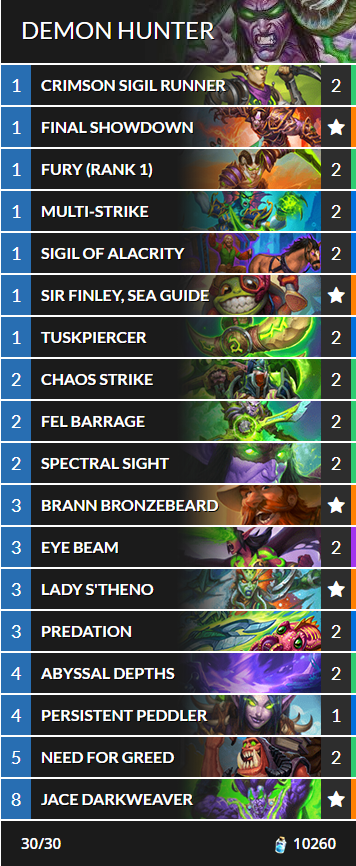
We may not have Expendable Performers and Felfire Deadeye to close out games with Quest Demon Hunter anymore, but we did get Brann Bronzebeard back, and when he teams up with Jace Darkweaver (which you can do once you’ve drawn them post-quest), you can still put out a disgusting amount of damage. Note that Sir Finley, Sea Guide (formally named Sir Spinley due to the amazing Diamond animation) is included only for loading Brann and Jace back into your deck if you’ve drawn them pre-quest completion so you can get the discounts on them. Even having one at full price still allows you to combo on 9 mana, however. (Important note: Finley doesn’t advance the quest because it doesn’t draw cards, so it’s intended to be saved only for after the quest is complete.)
Druid
AAECAZICAA/oFa3sA7PsA8n1A4H3A4T3A6yABK+ABOGkBOekBJelBJC1BPq9BLi+BK7ABAA=
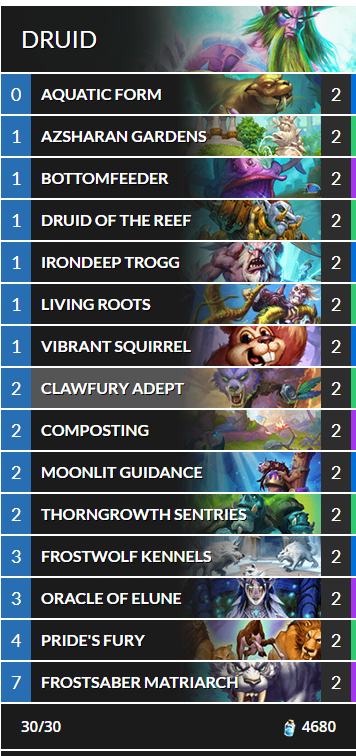
Beast Druid loses Arbor Up and Umbral Owl, and while these are pretty significant pieces, it does get the Aquatic Form/Azsharan Gardens combo to provide consistent buffs throughout the game; ideally on turn 2, you play Gardens and then dredge up the Sunken version with Aquatic Form, at which point your minions have a buff for the rest of the game that Prince Keleseth would approve of. Living Roots is a flexible addition to Core that provides removal in the early game along with replacing some of the tokens that the deck loses due to Adorable Infestation rotating, and we try to replace some of the burst power lost from Arbor Up via Pride’s Fury and Clawfury Adept. It may not be a terror of the meta like it has been, but this deck still retains enough of the core to be a viable ladder option.
AAECAZICBK6rAomLBN6fBKCwBA3EBugVrIAEr4AEiZ8Erp8E2p8EvaUEyqwEz6wEjbIE+b0E/70EAA==
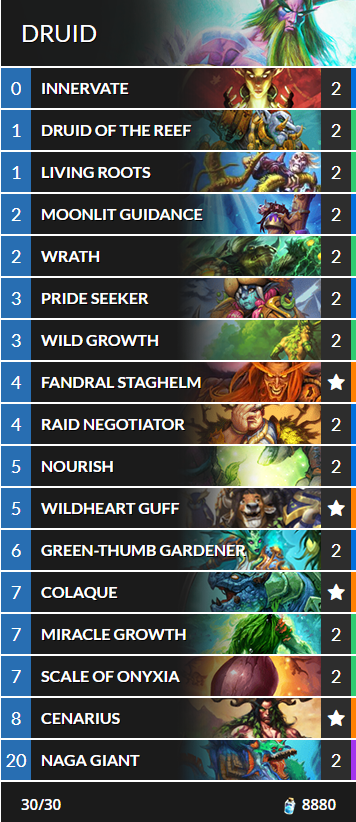
It seems like, whenever Druid’s lost so many key cards that it’s unclear how it will continue to go on, Fandral Staghelm shows up to pick up the pieces. We likely don’t have enough consistent ramp and draw to just force out Kazakusan and brute force games anymore (thank goodness), but we got enough choose one synergies over the last couple of sets to make that a viable strategy now, and the return of Fandral to say “Why not both” just sweetens the pot. In particular, Wrath becomes deal 4 damage and draw a card, Nourish draws 3 cards and refunds 2 mana (and has been buffed back to its original 5 mana cost), and Cenarius becomes Arbor Up on a stick. Along with Wildheart Guff and Moonlit Guidance, plus the addition of Naga Giants to pay off all of that mana spent on spells, there might be enough value here to win games in a four set meta.
Hunter
AAECAR8G5e8D/fgD25EEl6AEhMkEhskEDOaWA9zqA9vtA/f4A6mfBKqfBOOfBLugBL+sBMGsBJ2wBIHJBAA=
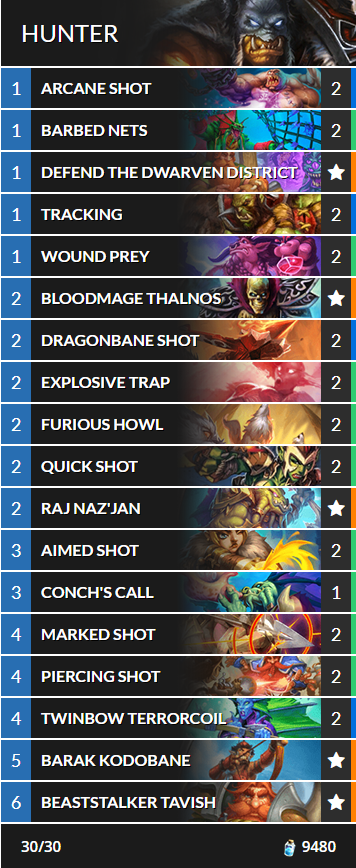
Quest Hunter is one of those decks that kind of builds itself. Just open the client, search for damage, and click all the cards. Most of the really good damage cards carried over from Year of the Gryphon, plus Marked Shot (returning to Core) provides some additional spell generation, Barbed Nets provides another cheap damage spell, and a small Naga package provides some draw and additional damage output. If you liked Quest Hunter before, you should be pretty comfortable with this year’s new model.
AAECAR8IgPMC5pYD5e8D25EE15IE4Z8E2qME57kEC7UD6ukD9/gDqZ8Eu6AE16ME2KME5aQEwKwEwLkEg8gEAA==
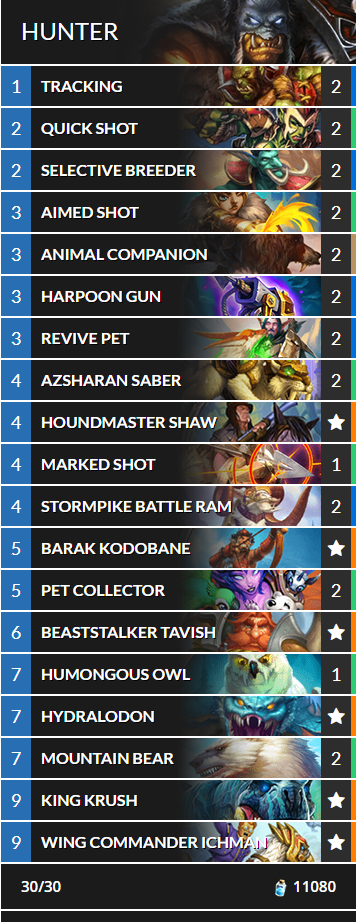
If you, much like Sir Mix A Lot, like big butts and cannot lie, this seems like the deck for you! Hydralodon and Azsharan Saber are the big upgrades to this archetype, and we include enough beasts that Harpoon Gun is likely to dredge one off the bottom whenever it attacks. Hydralodon in particular works well with summon and resummon effects like Wing Commander Ichman and Revive Pet, and when combined with Houndmaster Shaw can represent a full board clear. This deck might need a few turns to get going, but once it does, the parade of gigantic beasts could be too much for an opponent to handle.
AAECAR8GhRfl7wO/rATnuQSywQSGyQQM9/gDw4AEu6AElbAEnbAE7bEEhLIEiLIEyLcE4LkEgckEhMkEAA==
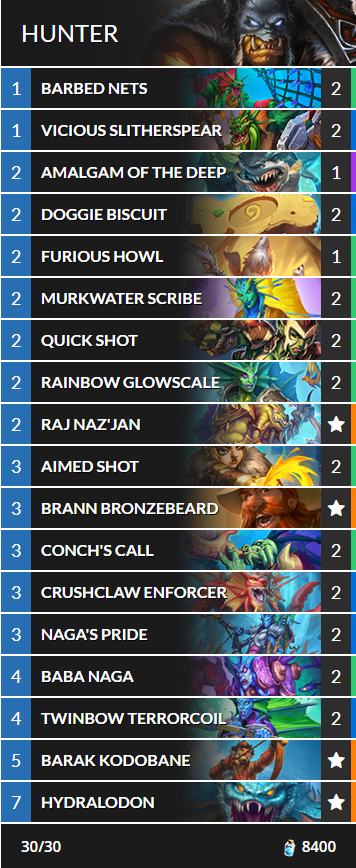
It’s been quite a while since we’ve had a true Midrange Hunter, but Nagas might be the way to bring this archetype up from the depths of the meta rankings. The neutral Nagas tend to be lower costed and synergize well between each other, and Hunter has spells that can remove threats and/or do face damage that work well with what Nagas naturally want to do. Conch’s Call in particular is a fairly potent draw engine in a deck like this, Naga’s Pride turns into a better Emerald Spellstone, and the Hunter Nagas, Twinbow Terrorcoil and Raj Naz’jan, can add enough damage to the spells that go face to carry this deck over the top. Brann fits in nicely in this deck as well, given most of the Nagas have favorable battlecries that we can double for extra oomph.
Mage
AAECAf0EBoUXw+oC2OwDoIoE+6IE/6IEDMkDpIcD0+wD1uwDkoEEk4EElIEEn5IEoZIE+qwE7bEEjbIEAA==
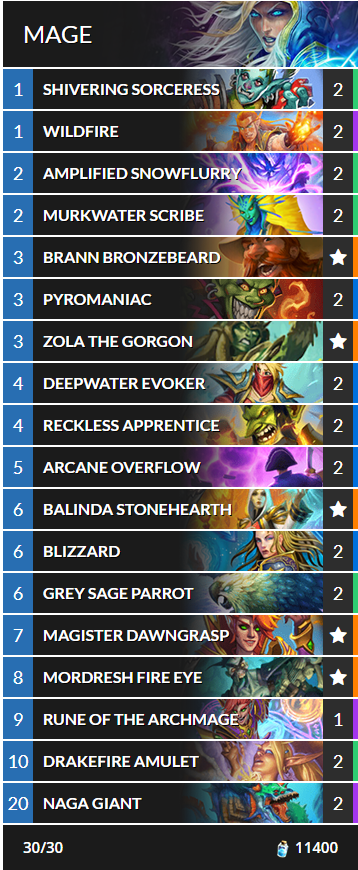
Wildfire/Big Spell Mage got a new endgame option in Naga Giant, which takes all those expensive spells and turns them into cheap tempo. Pyromaniac’s return to Core is also an obvious addition to the deck, as he allows for additional draw to find things like Mordresh or Magister Dawngrasp to try to close out games. It does remain to be seen if this is enough to get Wildfire Mage into the meta conversation; it’s seemed almost good enough for an entire year, but the upgrades it’s gotten going into another four set meta could be the shot in the arm it needs to ping its way to victory.
AAECAf0EAtu5BKneBA7U6gPQ7AOu9wP0/AOogQSKjQTtsQSEsgS8sgSHtwSWtwTItwTcuQThuQQA
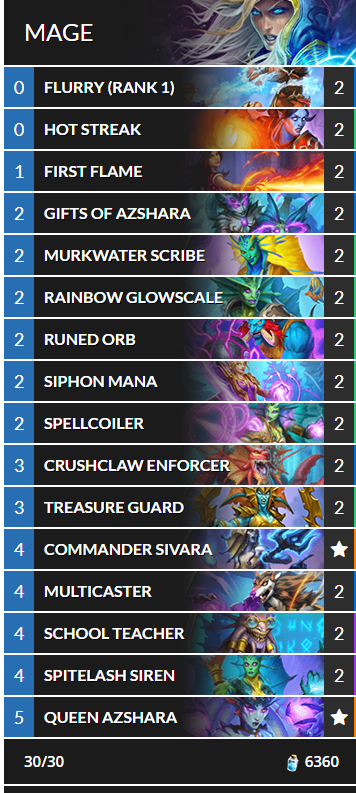
Spitelash Siren is a card that is a classic build around card, allowing for an extremely explosive pop off turn given the right mix of cards to fuel it. We’ve seen recently what cards like Nazmani Bloodweaver and Field Contact can do when their decks are refined. It will probably take a bit to get Siren to that point, but this is a first attempt at it. The Nagas all synergize with each other, Sivara can provide additional spell fuel, and the 5 health on the Sirens can make them very hard to remove, allowing for a turn with full mana to pop off even harder. The concern is what the endgame is, and this version of the deck doesn’t really have one, to be honest. It will remain to be seen if just a board of Nagas along with some spell generation along the way is enough to win games, or if a more focused game plan is needed. For day one of the meta, you don’t need to worry as much about that, though, just spam Nagas and be happy.
AAECAf0EBr8IhReoigShsQTHsgTsugQM3xbD+QP8ngTWoAThpAThtQTJtwTKtwTduQTjuQSywQTY2QQA
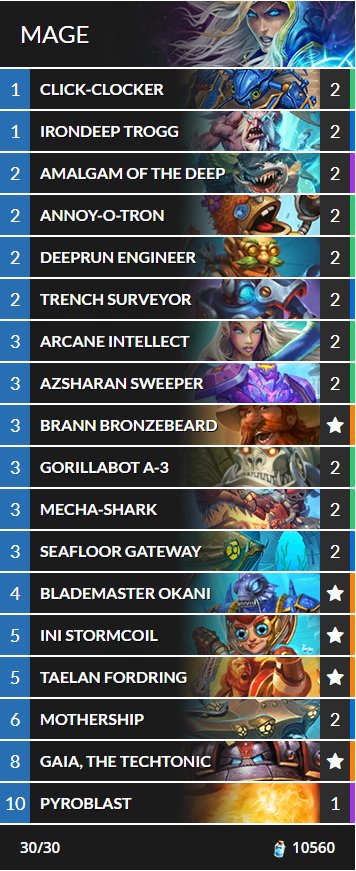
Players who have been with the game for a long time have nostalgia for Mech Mage; personally, it was one of the first meta decks I remember playing back in the Blackrock Mountain meta. The modern version will play more like a minion synergy deck than a spell based tempo deck with mech synergy thrown in, as cards like Trench Surveyor reward going all in on mechs for full value. As with most of the tribal decks, we run Amalgam of the Deep for additional value, and Core brings back a buffer version of Gorillabot A-3, a Spider Tank who gets you more mechs. Ideally, you’ll get Gaia, the Techtonic down with a board full of mechs and repeatedly Consecrate the board, after which it should be pretty hard for an opponent to recover. If Blizzard really does want us to play minions in Mage after a year of Deck of Lunacy and Quest Mage, this is a pretty good way to start.
Paladin
AAECAZ8FBpHsA6L4A8f5A7+ABOCLBLCyBAzfFvD2A6r4A8mgBOGkBPmkBOG1BN65BNS9BLLBBNrTBNrZBAA=
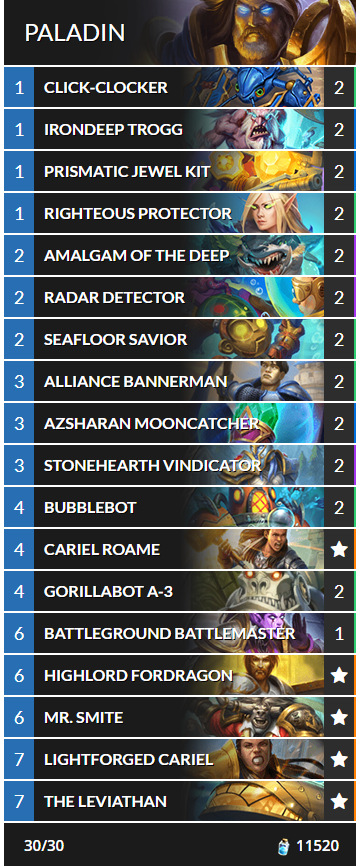
We’re going to have to mech this happen, aren’t we? Mech Paladin is looking to capitalize on Radar Detector, one of the scariest Paladin cards to be printed since Call to Arms. As such, we want most of our minions to be mechs to try to get full value from Detector. Unlike in Mage, where most of the mechs have powerful battlecries, in Paladin we’re taking advantage of divine shield synergies, since many of the mechs have divine shields or grant them to other minions. As a result, hand buffing is the way we’re going here, adding in Prismatic Jewel Kit and Highlord Fordragon to capitalize on when the divine shields pop. The rest of the non-mechs lean in on the divine shield theme as well, or otherwise are good at receiving hand buffs; Mr. Smite and Irondeep Trogg are honorary mechs for the purpose of this deck because they’re so good in an aggressive Paladin deck that it seems wrong to leave them out.
AAECAZ8FBvvoA5HsA8f5A7+ABOCLBKHiBAzM6wPw9gON+AO2gATJoAT0pAT5pATMrATQrATQvQTXvQTavQQA
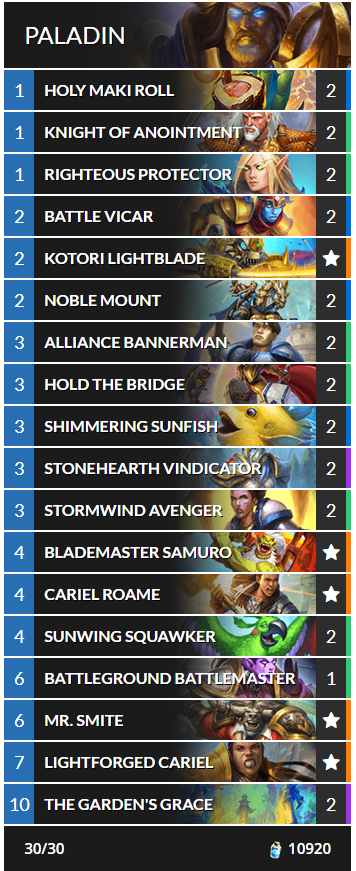
Buff Paladin was one of the better decks toward the end of the last Standard year, and while it does lose Blessing of Authority and Hand of A’dal, it keeps enough of the rest of the core to carry over more or less intact. We did get some additional Holy synergies, so we add Holy Maki Roll, which enables the battlecry on Shimmering Sunfish (aka Pogfish), as well as can buff the attack on Stormwind Avenger, and also discounts The Garden’s Grace, which is our new replacement for Blessing of Authority. +5/+5 is less than +8/+8, but the divine shield and the fact that the buffed minion can hit face the same turn as the buff does seem worthwhile. Even if some of these cards feel like a downgrade, Lightforged Cariel might just be the most improved card in Standard by virtue of staying the same as it was before.
Priest
AAECAa0GBr7IAsPqAtTtA4SwBImyBNu5BAz2B/IM2MECrYoEhKMEiaMEiqME7bEEorYEpLYEp7YEh7cEAA==
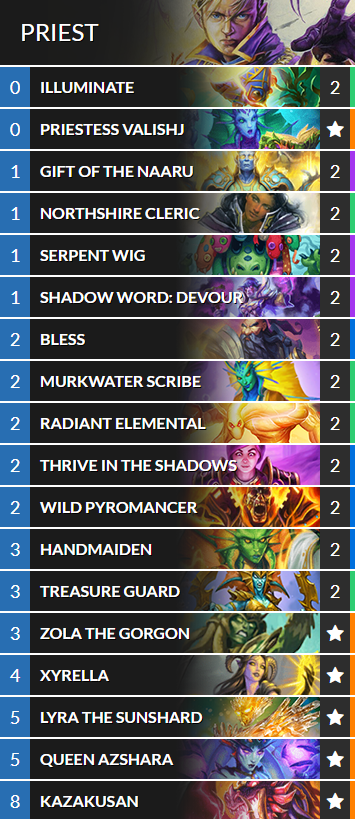
BEHOLD THE GLORY OF A NEW SUN! If you weren’t yet playing Hearthstone when Lyra the Sunshard was legal in standard the first time, boy, are you in for a treat! This version goes in on Serpent Wig to try to recur spells discounted by Radiant Elemental, interspersed with building a board with cheap Naga to get more Wigs. Along with all the draw enabled by Northshire Cleric/Wild Pyromancer/Gift of the Naaru, you can have a big pop off turn, and if all else fails, you have Kazakusan to close out games where Lyra refuses to hand you lethal.
AAECAa0GAsf5A4ujBA7yDMH5A8v5A6yKBOCgBISjBImjBIqjBI21BKK2BKO2BLi2BMfABL7cBAA=
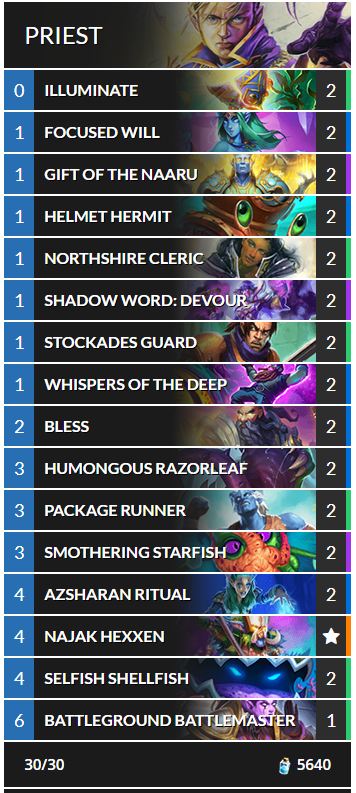
We got a series of cards that provide obvious Silence Priest direction in Voyage to the Sunken City, complete with a 1 mana 4/3, a 4 mana 7/7, and several spells that capitalize on silencing your own minions to copy them or clear the opponent’s board. We can also do classic Handlock things with Stockades Guard, a 1 mana minion with a battlecry that gives another minion taunt, which can buy a lot of time in the early game. Later on, Azsharan Ritual can copy one of your giant minions, and then Illuminate can dredge up the sunken copy to make even more chonky bois. Battlegrounds Battlemaster, Shadow Word Devour and Bless combine to give the deck the reach it needs to close out proceedings once one of the big minions sticks to the board. Also, don’t sleep on Najak Hexxen in the list; combined with Focused Will or Whispers of the Deep, he turns into a permanent Mind Control for 5 mana.
AAECAa0GBI6xA4f3A6WtBISwBA3hBLkGjQi6uwKe6wOI9wOtigSFnwTBnwS6rATIrATUrASywQQA
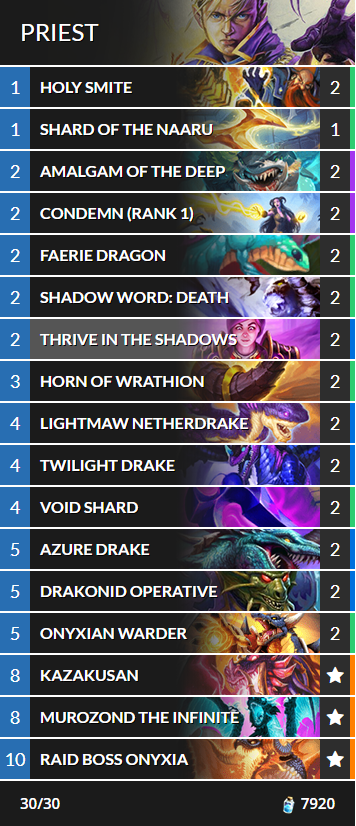
If you ask most Hearthstone players what their favorite Priest deck of all time is, most will answer Dragon Priest. I may be sorry for those people most of the time, but I’m happy for them now, because it looks like we have enough dragons returning to the Core set to make Dragon Priest possible again. With the return of Azure Drake, Drakonid Operative (SECRET AGENT, COMING THROUGH!) and Murozond, we have a critical mass of good dragons available, along with a reasonable replacement for Netherspite Historian in Amalgam of the Deep, and Horn of Wrathion providing extra value for a dragon-heavy deck. We’re running just enough Holy and Shadow spells to try to get Lightmaw Netherdrake to trigger its battlecry, but even when it doesn’t, it’s still a 4 mana 4/4, which is probably good enough to tempo out. This could be the fairest Priest deck of all time, which could mean it’s not good enough for ladder, but at least it’ll win on nostalgia.
AAECAa0GCtTtA6bvA932A4f3A6D3A6iKBOiLBNasBMeyBKi2BAqKAZIPlugDmusDnusDzfIDrYoEiKMEiqME1KwEAA==
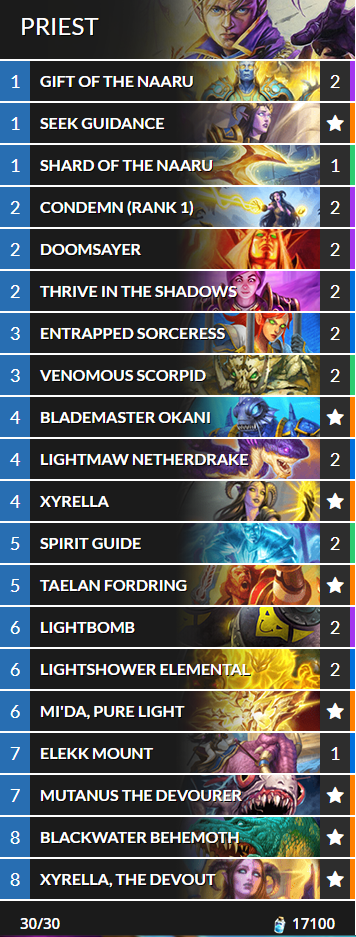
I’ll be honest here: The sudden nerf to Pandaran Importer to 3 mana actually hurt Quest Priest quite a lot, and this is an archetype that was already tier 3 (at best) up to now. Nevertheless, we persevere, and the return of Doomsayer gives us a viable 2 cost card that we can happily drop on curve to advance the quest. With the loss of Pandaran Importer (along with Palm Reading and Wandmaker to rotation), we’re forced to run both Venomous Scorpid and Entrapped Sorceress in the 3 mana slot to ensure we have enough control tools to start focusing on moving our quest forward. The big change here is at the second 8 mana spot, where Blackwater Behemoth replaces Mo’arg Forgefiend; the high mana cards are often the most difficult to play in the face of opposing pressure, but Behemoth providing both 8 healing and removing an enemy minion should make it a bit easier to complete the quest.
Rogue
AAECAaIHBL+ABO2ABPuKBK+2BA2bFZCXA6rrA6aKBPafBK+gBO6gBJm2BKC2BLLBBIrJBJjbBJrbBAA=
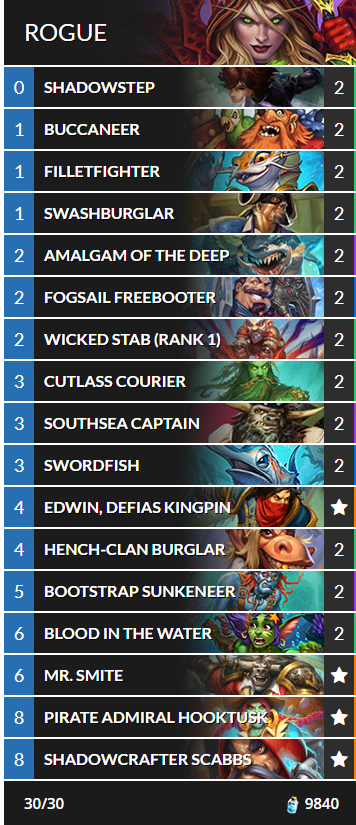
Hooktusk got a very obvious promotion to Admiral in Voyage to the Sunken City, but so did her crew. The pirates available to Rogue as of this expansion are really strong, with Bootstrap Sunkeneer bringing back Vilespine Slayer (Sailor?) vibes, Cutlass Courier providing a potent draw engine on a 5 health body that’s extremely difficult to remove, and Swordfish buffing both its own attack and the attack of the pirates that are summoned while it’s equipped. If all that’s not enough, you get to plunder your opponent with Hooktusk herself, which may be enough to get your opponent to walk the plank on their own before you even get to use the cards you plunder. Pirate Rogue seemed like one of the stronger decks in the theorycrafting streams, so it may be a good choice for plundering ranks from your opponents in a new meta.
Shaman
AAECAaoIAA/wB5MJoLYCqIEElZIE25QE+Z8E4aQE+rQE4LUE4rUEvLYEvbYEircEnMcEAA==
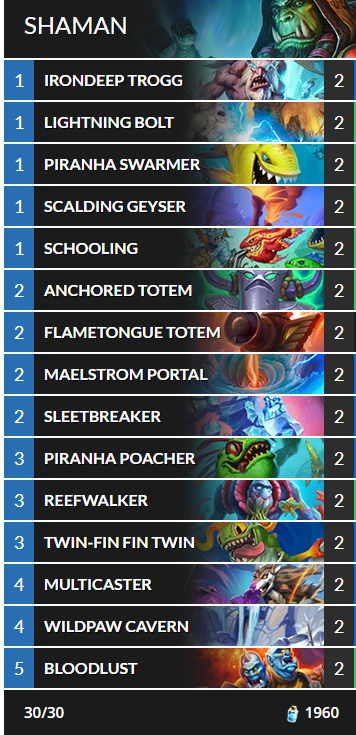
Once I saw that Bloodlust was back, I remembered that Pirahna Swarmer was revealed very early on, and we had all promptly forgotten about it. There is enough Swarmer synergy to get the fish friends fairly large, and you just need to stick one board to be able to Bloodlust your opponent for lethal. Should that not be enough, the deck does feature a small burn package to get over taunts, which also activates Multicaster for extra draw. This is also one of the most budget friendly lists in this roundup, featuring only commons and rares. So if your pack openings turn out to be not what you wanted, head for pirahna infested waters!
AAECAaoIAsGJA8ORBA6gtgLq5wOF+gOogQS5kQT5kQSVkgTckgTblAT5nwTCrAS8tgSNugSZ2wQA
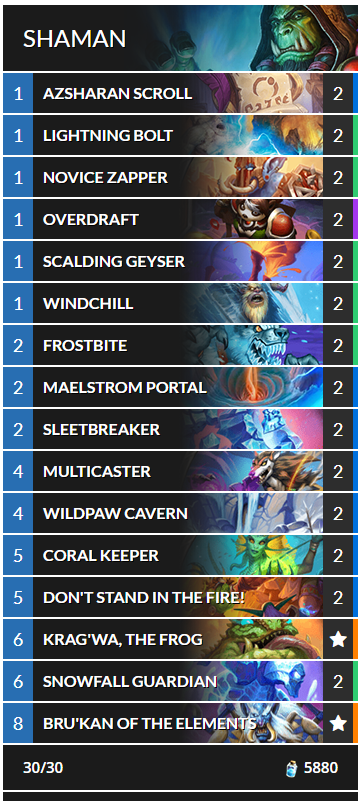
It took eight years, but it seems like we’ve finally settled on Shaman’s identity being the spell school class. In this case, Spell School Shaman seems to be trying to take the place of Burn Shaman, which will be hard with the losses of Lightning Bloom and Serpentshrine Portal, but the introduction of Azsharan Scroll and the return of Krag’wa the Frog could give the deck the reach it needs to burn the opponent down after using the usual tempo tools in the early game. Wildpaw Cavern will certainly not be as good when it’s coming out on 4 as opposed to 2, but it still represents a lot of damage and board control that helps bridge to the late game.
AAECAaoIBML2A8ORBPmfBOe1BA2KAbIG6ucD+uwDwfYD5PYDhfoDqIEE8IUEuZEElZIE+p8EwqwEAA==
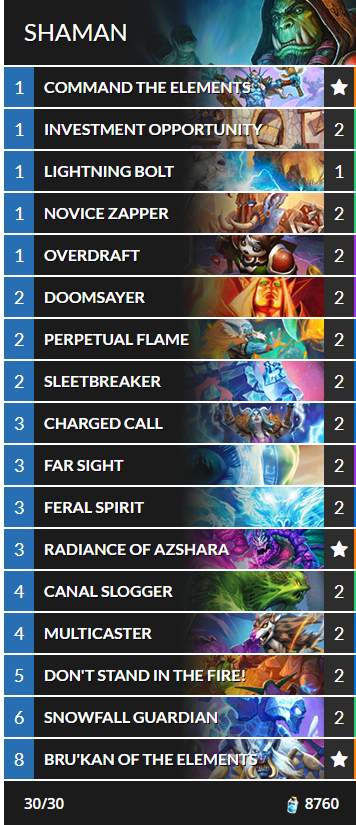
Quest Shaman took a pretty big hit with the losses of Lightning Bloom, Serpentshrine Portal and Instructor Fireheart to rotation, but it still has plenty of viable overload cards and Charged Call to make it worth trying. We didn’t get any new overload cards in Sunken City, so we’re filling in the gaps with the B-tier overload cards, Doomsayer and Radiance of Azshara to try to take advantage of the spell density in the deck. This may be a deck that needs another set or two to come back to the forefront, but if you’re at a loss of what to play, it should still be reasonably complete.
Warlock
AAECAa35Awby7QOwkQTxkQSXoATbuQT1xwQM1+0DvfEDwPkDgfsDg/sDxYAEqIEEj58EsZ8E56AE26MEiLAEAA==
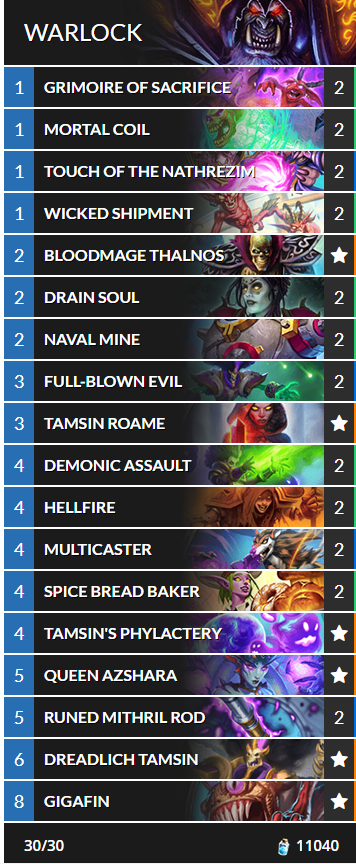
Owls are so yesterday. Sunken City brings us Naval Mine, which is easier to get into play at 2 mana, and can’t miss your opponent’s face. We do lose an easy trigger for clearing the Phylactery board in School Spirits as well as efficient draw from Backfire, so we attempt to compensate with Hellfire and Multicaster, respectively. Queen Azshara’s Ring treasure can add some additional damage output against armor classes, providing an extra activation of Tamsin’s Phylactery for 1 additional mana. It’s possible that the loss of Backfire could just be too much for OTK Warlock to withstand, but given that it remained viable despite how many times this deck was nerfed over the course of Alterac Valley, it wouldn’t be wise to count it out entirely.
AAECAa35AwjL7ALy7QOC+wOwkQSFoATHsgTmvQT1xwQL3sQCwPkD/voDg/sDsZ8Eg6AE56AE26ME/rQE3L0E4r0EAA==
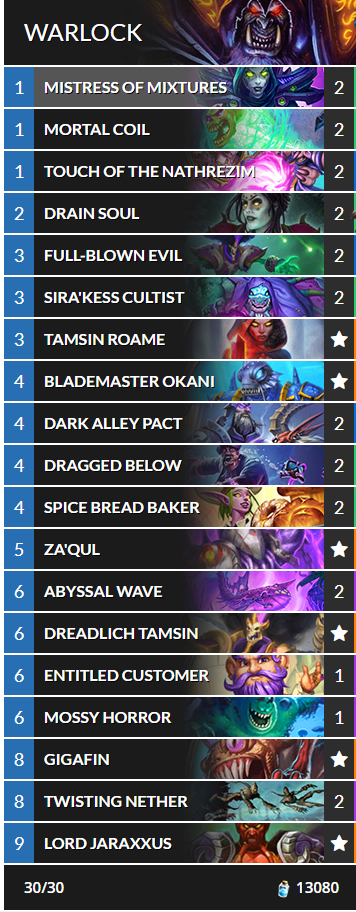
So it turns out that Abyssal Curses could actually be blessings in disguise. This is a control deck in the vein of Bolner OTK Shaman or my beloved Mind Blast Priest, as the damage from the curses can add up quickly as the game progresses. Warlock keeps most of its good removal from Year of the Gryphon, and removal is all it really needs to stall the game out and let the curses do their magic. Little Tamsin can double up on some of those curses, and we run as much healing as possible to try to tap every turn to find more curses and control tools. Jaraxxus in this deck is honestly probably overkill, but it’s been a minute since we’ve gotten to hear his laugh, so why not face him again?
AAECAa35AwLVsgT1xwQOpwiT6AOU6AO1nwSroAThpASxsAS6tAS+tASAtQTjvQSywQScxwT+2AQA
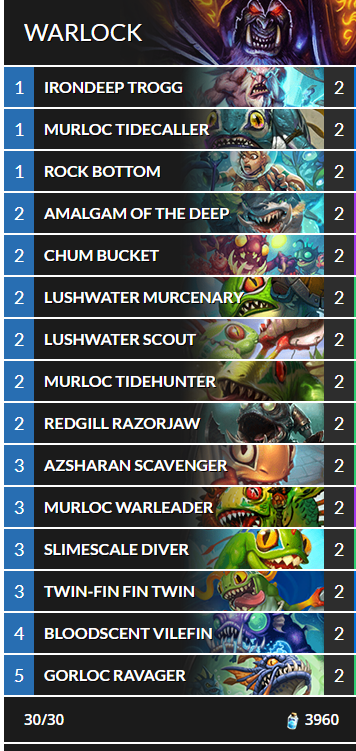
This is less of a zoo and more of an aquarium, and it honestly remains to be seen if Murloc Zoo sinks or swims, but we did get enough fishy friends to at least test the waters. The deck is going to hinge on how good Chum Bucket performs; if it turns out to be Conditioning on steroids, this could surprise some people. It could also be an archetype that’s waiting for the miniset to bring the missing pieces with it.
Warrior
AAECAQcEju8DmPYDv4AEqbMEDf7nA9XxA5X2A5b2A5f2A8/7A5yBBKaKBK2gBK+gBIqwBJC3BLLBBAA=
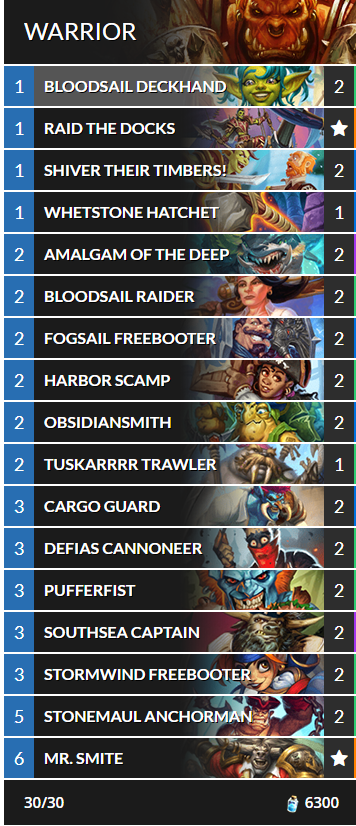
Quest Warrior may have proven less seaworthy toward the end of the last meta, but Voyage to the Sunken City brought enough new scallywags with it that your flag can mean death once again! As with most tribal decks, Amalgam of the Deep is two pirates in one, which in this case means two quest ticks in one; Pufferfist uses the weapons you plunder along the way to turn into AoE damage; and Obsidiansmith finds you another pirate and buffs it. It remains to be seen how Rokara’s new crew will navigate the rough seas of a new meta, but a straightforward course of pirates to face might be good enough to turn the tides on an unexplored meta game.
AAECAQcEx/kDv4AEvIoEiqUEDf8HqRWO7QOP7QPF9QP5jAT6jASIoASJoASsoAT8ogSLtwSMtwQA
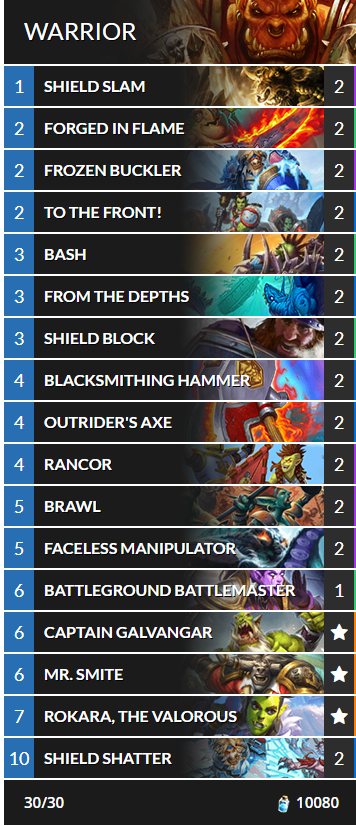
The Galvangar combo finish (To the Front x2 + Captain Galvangar + Faceless Manipulator + Battleground Battlemaster) comes over to the Year of the Hydra unchanged, and it gets some new tricks. If you regularly find your combo pieces stuck at the bottom of your deck, From the Depths helps flip the script, discounting those submerged cards and dredging one up, which allows your combo to come together a bit more quickly. To find the rest of the combo, we utilize the tradeable Blacksmithing Hammer along with new spell Forged in Flames, which draws cards equal to the weapon’s attack; 2 mana to draw 5 cards does a lot of work to find combo pieces to bash your opponent’s face in. (If you’d like, you can use the card named Bash to do that also, as that’s made its way back to Core and into the list as well.)
AAECAQcEyccCvIoEpa0EhLAEDbkG/wepFY7tA4/tA8X1A/iABPmMBPqMBIigBImgBNKsBIu3BAA=
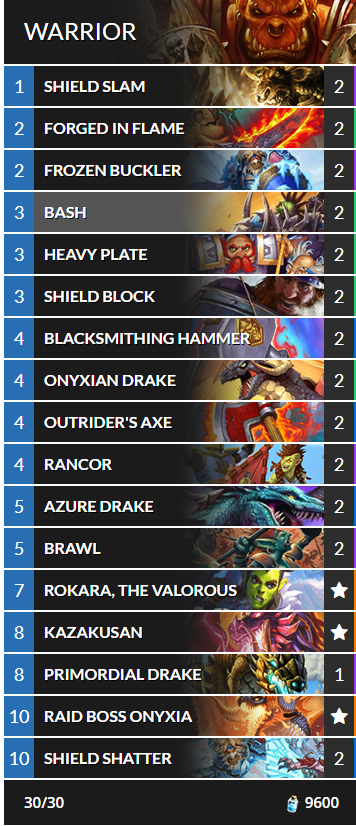
If you, like me, prefer to tank up to rank up, Kazakusan Warrior still seems like a perfectly good control deck. Primordial Drake coming back to Core suits this archetype perfectly; it presents a wall for the opponent to get through while also clearing any small minions off the board. We do miss some of the early removal spells like Bladestorm and Minefield, but we again rely on Forged in Flame for bulk card draw, and we welcome back old friend Azure Drake to help with additional cycling as well as giving some extra oomph to the damage based removal.
Thanks for reading!
If you enjoyed this content, please follow me on Twitter and Twitch and subscribe to Coin Concede, the weekly podcast that I co-host that focuses on making competitive Hearthstone accessible. Enjoy the new set!
